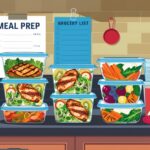How to Read Nutrition Labels for Healthier Choices
How to Read Nutrition Labels for Healthier Choices: Making healthy food choices can be challenging with so many products available. Nutrition labels are a helpful tool to guide you in choosing foods that align with your health goals. Understanding these labels allows you to make informed choices, especially when aiming to reduce sugar, fat, and calorie intake. This article breaks down each section of the nutrition label so you can confidently select healthier options.
Why Nutrition Labels Matter: Nutrition labels provide essential information about a product’s contents. From calorie count to nutrient values, these labels help you see the nutritional value of what you eat. By learning to read them, you can avoid foods high in unhealthy fats, sugars, and sodium while prioritizing foods rich in fiber, vitamins, and protein.
Understanding Each Section of a Nutrition Label
1. Serving Size
The serving size is the first item you’ll see on a nutrition label. It shows the recommended portion size and the number of servings per container. All other nutrition values on the label are based on this serving size.
Why It’s Important:
- Helps in portion control
- Allows you to calculate nutrient intake accurately
Tip: Check if the package contains more than one serving. If you eat multiple servings, remember to multiply the values accordingly to get the total intake.
2. Calories
Calories measure the amount of energy the food provides. They’re vital for daily energy needs but consuming too many can lead to weight gain.
Key Points:
- Daily calorie needs vary by individual; most adults require around 2000 calories per day.
- Low-calorie foods (100 calories or less per serving) are ideal for snacks, while high-calorie foods should be eaten in moderation.
Tip: When trying to lose weight or maintain a healthy diet, aim for products with fewer calories per serving.
3. Total Fat
The fat section includes the total fat content along with the types of fat: saturated and trans fat. These types are linked to heart disease when consumed in excess.
What to Look For:
- Saturated Fat: Aim to keep this as low as possible, as it can raise cholesterol levels.
- Trans Fat: Try to avoid trans fat entirely, as it’s harmful to heart health.
Tip: Choose products with unsaturated fats, which are healthier fats found in nuts, seeds, and fish.
4. Cholesterol and Sodium
Both cholesterol and sodium levels are listed because high amounts can negatively impact heart health. Excess sodium is particularly common in processed foods and can lead to high blood pressure.
Guidelines:
- Aim for less than 300 mg of cholesterol daily.
- Limit sodium intake to around 1500-2300 mg per day.
Tip: Look for “low-sodium” or “reduced-sodium” labels if you’re trying to reduce salt intake.
5. Total Carbohydrates
Carbohydrates provide energy and include sugars, dietary fiber, and sometimes added sugars. Each type has a different effect on your body.
What to Focus On:
- Dietary Fiber: Look for products high in fiber (at least 3-5 grams per serving) as it helps with digestion and keeps you full.
- Sugars and Added Sugars: Keep added sugars to a minimum. The American Heart Association recommends less than 25g of added sugar daily for women and 36g for men.
Tip: Choose whole grains and high-fiber foods for long-lasting energy, and avoid foods with high added sugars.
6. Protein
Protein is essential for muscle repair and overall health. Nutrition labels indicate the grams of protein per serving, making it easy to compare products.
Daily Needs:
- The average adult needs about 50 grams of protein daily, though individual needs may vary based on age, activity level, and health goals.
Tip: Opt for protein-rich snacks like yogurt, nuts, or lean meats to keep you full and maintain muscle.
7. Vitamins and Minerals
Vitamins and minerals such as Vitamin D, calcium, iron, and potassium are listed to help consumers identify foods rich in essential nutrients. Each is expressed as a percentage of the recommended daily value.
Why It Matters:
- Helps ensure you’re getting enough essential nutrients
- Vitamins and minerals support immunity, bone health, and energy levels
Tip: Select products that provide a high percentage of these nutrients to support a balanced diet.
Additional Tips for Using Nutrition Labels
- Look for % Daily Value (DV): The percentage shows how much of each nutrient the food provides in a typical daily diet. Aim for foods with high % DV in vitamins, minerals, and fiber and low % DV in fats and sodium.
- Ingredients List: Ingredients are listed in descending order by weight. Check this list for added sugars, artificial flavors, and preservatives, and prioritize products with whole, recognizable ingredients.
Conclusion: Reading nutrition labels empowers you to make healthier choices and understand what’s really in the foods you eat. By focusing on serving size, calorie count, fats, carbohydrates, protein, and vitamins, you can confidently select foods that align with your health goals. Over time, this practice will become second nature, helping you maintain a balanced and nutritious diet.
See More


